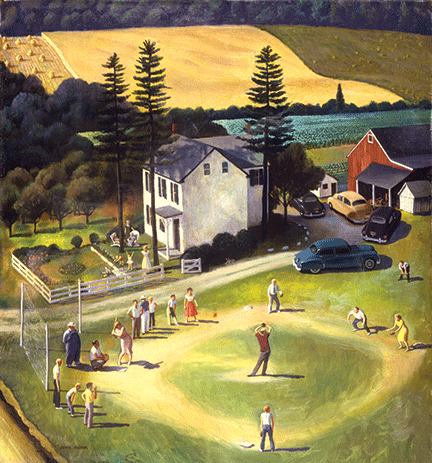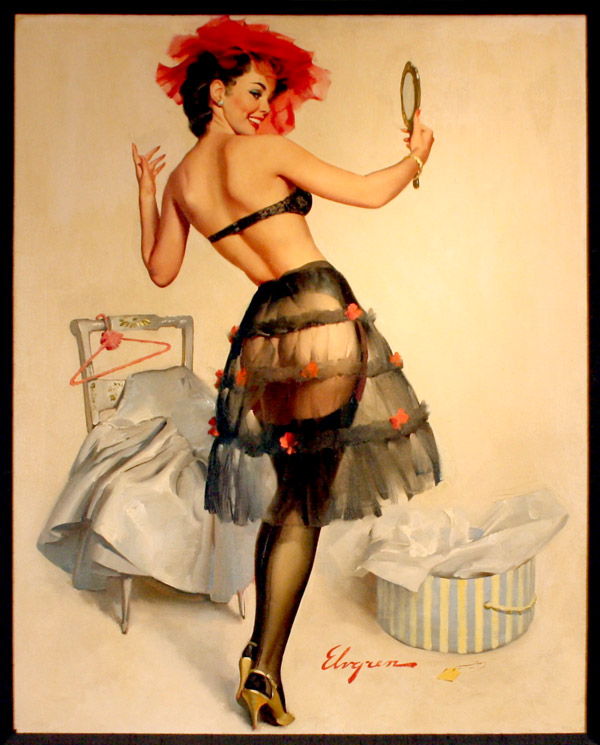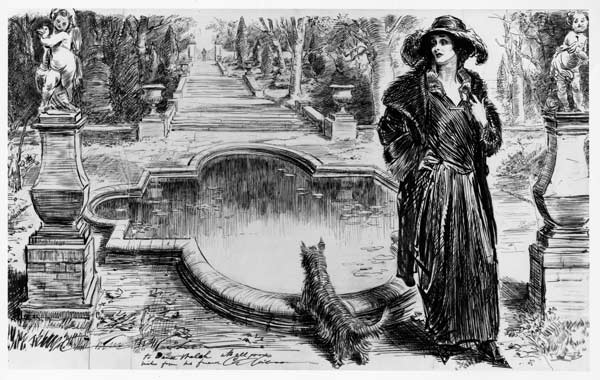

Norman Rockwell & His Contemporaries:
The Fabulous Forties to Sensational Sixties
The period from the 1940s through the 1960s was a tumultuous time in the history of the United States. Significant political and social changes defined daily life for Americans as a result of the frequent shift between wartime and peacetime. Featuring original paintings, works on paper, vintage posters, and accompanying artifacts, Norman Rockwell & His Contemporaries: Fabulous Forties to Sensational Sixties, highlights the changes to daily life in America during three very different decades. Through illustrations created for advertisements, magazines, newspapers, and more, artists showed how American culture and values changed in concert with the constant political unrest. The exhibition culminates with a celebration of the 50th Anniversary of the Apollo 11 Moon Landing on July 20th, 1969.
During WWII, while American men fought for the side of the Allies, women experienced new-found freedom as they entered the work force, taking on the jobs that were left behind. When the War ended, many of the veterans who returned home went back to work, got married, and started families. This ushered in the era of the 1950s Nuclear Family – a term for the stereotypical family consisting of a working husband, housewife, and typically two children. Images of leisure and wholesome family life prevailed in the Fifties. The Sixties brought the Civil Rights and Women’s Rights movements, seeking to overturn political policies and improve the daily lives of women and minorities. The travel boom expanded the average American’s accessibility to the rest of the world – and beyond. It was also this increase in technological innovation that led to an American, Neil Armstrong, becoming the first person to set foot on the moon.
Norman Rockwell & His Contemporaries: Fabulous Forties to Sensational Sixties will explore this exciting time in American history through the images of the Nation's most beloved illustrators, reflecting and molding the society evolving around them.

American Illustration and the First World War
Currently on Display
American Illustration and the First World War celebrates the 100th Anniversary of the resolution of “The War to End All Wars” by honoring the essential work the American illustrators accomplished in swaying opinions and rallying National support for the war effort.
When the First World War broke out in June 1914, United States President Woodrow Wilson declared the US to be neutral, a popular decision with the public. However, as the War escalated over several years, the United States Congress ultimately declared war on Germany on April 6, 1917. Just one week later, President Wilson formed the Committee on Public Information with the purpose to “sell” Americans on the War and change public support in his favor.
Charles Dana Gibson, one of America’s most popular illustrators, was named head of the Division of Pictorial Publicity. In just over 19 months, Gibson and an army of over 300 artists, all unpaid volunteers, produced 1,438 designs for posters, buttons, cards, cartoons, and more to flood the Nation with their message. These widely circulated images strived to accomplish one of three primary goals: to raise money, to conserve food and resources, or to promote enlistment and patriotism.
Featuring original paintings, works on paper, vintage posters, and accompanying artifacts, American Illustration and the First World War displays these artworks as powerful, emotional reminders of the hardships and threats the United States faced during this time, and highlight the critical role the American illustrators played in the outcome of the War.

Howard Pyle, His Students &
The Golden Age of American Illustration
Howard Pyle, His Students & the Golden Age of American Illustration is a exhibition featuring oil paintings, works on paper, and accompanying artifacts that highlight the work of Howard Pyle, known as the “Father of American Illustration”, and the generation of celebrated illustrators he taught. In 1894, Pyle founded the first School of Illustration in America at Drexel Institute of Art, Science and Industry, now Drexel University, shaping the way illustrators created artworks thereafter.
“A.J. Drexel founded the Drexel Institute in 1891, and when he did, he made it clear that his vision should be accessible for both men and women from all backgrounds, which was unique for a college of that time period,” said Paula Marantz Cohen, Pennoni Honors College dean. “Pyle’s time at Drexel undoubtedly shaped the field of American Illustration. He was an early parallel advocate of Drexel’s philosophy of ‘learning by doing’ encouraging his students to go out into the world to study their subject matter, an approach reflected in Drexel’s present-day Co-op program.”
Howard Pyle taught at the Drexel Institute until 1900 when he founded the Howard Pyle School of Illustration in Wilmington, Delaware. His students at both schools became known as “The Brandywine School,” which included some of America’s greatest illustrators: Stanley Arthurs, Anna and Ethel Betts, Harvey Dunn, Anton Otto Fischer, Philip R. Goodwin, Elizabeth Shippen Green, W.H.D. Koerner, Violet Oakley, Frank Schoonover, Jessie Willcox Smith, Sarah Stilwell Weber and N.C. Wyeth.
Pyle’s innovative teaching methods encouraged his students to live their illustrations, therefore painting from experience, not merely from observation. This new principle, taught at the verge of the publishing boom of the 20th century, laid the foundation for a century of America’s iconic illustrators. His influences greatly contributed to illustrative painting and drawing becoming one of the truest forms of applied art.
“Today everyone knows the name Norman Rockwell but few people know the name Howard Pyle, let alone his art or his impact on generations of artists and American illustration,” says Judy Goffman Cutler, co-founder of the National Museum of American Illustration. “This exhibition will give viewers a first-hand and close-up look at the marvelous original paintings that most people have only seen in reproduction form.” To highlight the importance of Pyle’s teachings on all of America’s Golden Age illustrators, a selection of artworks from later periods will be on display, including Norman Rockwell, J.C. Leyendecker and Howard Chandler Christy.
A 260-page illustrated catalogue will accompany this exhibition, available for pre-order now through the National Museum of American Illustration’s Online Museum Shop, click here for more information.

The Art of Giving:
Recent Donations to the NMAI's American Imagist Collection
The National Museum of American Illustration (NMAI) is fortunate to have generous donors who assist the NMAI’s mission to “present the best venue for the public to appreciate the greatest collection of American illustration art,” by gifting artworks of historical and artistic significance. This exhibition highlights the latest gifts added to the collection.
The gifts on display in this exhibition emphasize the wide range of artworks and artifacts received in recent years. Many of these are works of pulp art, so named for the inexpensive paper on which they were printed. Pulp art was published from the 1890s to the 1950s, overlapping the era of the museum’s main collection, and contains numerous sub-genres. From fashion and pin-up illustrations, to covers for western, sci-fi, detective, romance, and crime novels, the scope of genres collected at the NMAI is ever-increasing, due in large part to the benevolence of these donors.
Recent donations include works from the Golden Age of American Illustration and beyond, including Frank Schoonover, Anton Otto Fischer, JF Kernan, Gil Elvgren, Peter Darro, Col. Charles Waterhouse, Stanley Arthurs, Richard Ely, Frank Kelly Freas, Ralph Crosby Smith, Robert McGinnis, and Stuart Kaufman, among others.
The NMAI is eternally grateful to its visitors, patrons, and donors, all of whom are equally essential to achieving the mission of the Museum. We thank you for your generous support.

American Muse
The American Muse exhibition is as much an homage to American women of the late 19th and early 20th centuries as it is to the illustrators who accurately portrayed the quintessential yet distinctly American feminine beauty these women embodied. The American illustrators highlighted include Charles Dana Gibson, Harrison Fisher, Philip Boileau, McClelland Barclay, Howard Chandler Christy, Walter Granville Smith and Albert Beck Wenzell.
Each of these illustrators created their own prototypical image of "The American Woman." The public gave these illustrators’ artworks generic names as part of their respective oeuvre, most popularly "The Gibson Girl" and "The Fisher Girl." These renditions of the feminine ideal captured the increasingly independent spirit of American women. The illustrations both shaped and reflected American society and its notions of female beauty. Compared to women of previous eras these women relished more freedoms, enjoyed greater opportunities in sports and education, and were in the vanguard during a time when women effected change through social and political movements on an unprecedented scale in Western culture.

John Rogers: The Norman Rockwell of Statuary
On Permanent Display
John Rogers was born in Salem, MA, in 1829. During the last half of the 19th century he was recognized as the preeminent popular artist of his time. Through his realist style, Rogers created reflections of everyday life in sculpture, just as Norman Rockwell subsequently painted on canvas. The NMAI is proud to display 29 unique John Rogers groups throughout Vernon Court.
Rogers had an early love of art, but his family hoped he would pursue a more traditional career. At the age of 16 he accepted a traditional apprenticeship in Boston, and would move through a number of jobs for the next 13 years. Finally, in 1858 Rogers travelled to Europe to receive a formal education in sculpting for one year.
Now 27, Rogers returned to New York City to open a production studio, beginning a full-time artistic career. Rogers wanted to create high quality, low-cost plaster casts of his sculptural “groups,” named because each sculpture usually contained two or more figures. By creating numerous casts of each piece, the cost remained reasonable, in the reach of middle-class Americans. In 1862, Rogers showed two of his groups at the National Academy of Design’s annual exhibition and was granted membership in 1863, a prestigious honor. Between 1860 and 1893, Rogers created 90 groups and those were reproduced as many as 100,000 times.
These groups generally fall into three categories: Civil War vignettes, everyday 19th century life, and theatrical scenes. During this time he employed up to 25 workmen in his New York studio. The process of reproduction began with a metal “master” sculpture, and a newly developed flexible gum mold process was used to duplicate it around metal armatures for stability. Delicate features, such as horse ears, were first cast in pewter and attached to the wet plaster statue, and lastly the whole statue was painted in a neutral color. By the 1890’s Rogers groups ceased to be fashionable and he sold the business in 1893. Sadly, he died nearly forgotten, in 1904.
